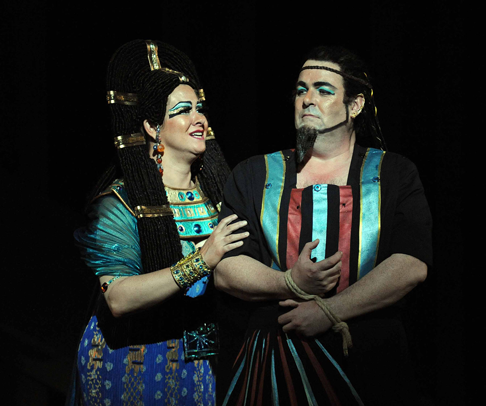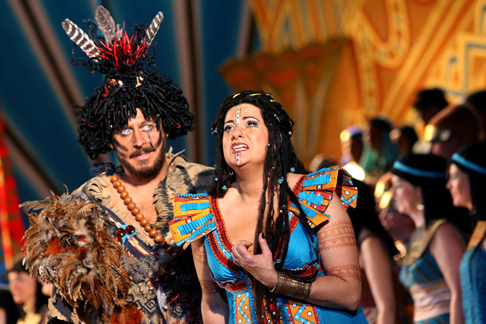13 Nov 2008
Aïda – English National Opera, London Coliseum
It is incredibly unfashionable nowadays to stage opera straightforwardly. Welsh National Opera’s recent lavish staging of Otello prompted a dismissive reception from the critics.

It is incredibly unfashionable nowadays to stage opera straightforwardly. Welsh National Opera’s recent lavish staging of Otello prompted a dismissive reception from the critics.
Traditional stagings of 19th-century opera have become something of an embarrassment to a genre which is still struggling to shake off the clichés which haunt its perception in non-opera-going circles. This is in spite of there still being a keen and thriving audience for those clichés; you need only look at the popularity of the Eastern European touring outfits which, with cardboard sets and cardboard acting, keep the standard repertoire alive in provincial theatres around the UK.
Jo Davies’ production of Aïda for ENO and Houston, which was first seen here in London a year ago, is not made of cardboard (though sometimes it looks as if it is made out of gift-wrap). Nor is it lacking in visual imagination, with its wacky turquoise and gold designs by Zandra Rhodes. Still, it ticks enough unfashionable boxes to guarantee divided opinions from opera aficionados and the theatrical establishment. Static direction – check; “spectacular” sets and effects – check; appeal to the masses – check. Remind me – why exactly is that last point a bad thing?
With last year’s cast returning almost wholesale, the revival was a known quantity, though a non-specific announcement was made at the start to excuse the possibility that several of the principals might not be at full strength having been unwell earlier in the week. Further investigation yielded the fact that this included both female leads, though here on the first night there was little to fault their performances. In the title role, Claire Rutter’s bright-toned soprano soared above the large ensembles but also made beautifully delicate work of ‘O patria mia’, and although Jane Dutton’s all-guns-blazing dramatic delivery often came at the expense of tonal beauty, her Amneris was always a force to be reckoned with.
Perhaps the most impressive singing of all came from Iain Paterson as Amonasro; his lovely legato and depth of emotional expression made me long to hear him in other Verdi ‘father’ roles.
The strength in John Hudson’s Radamès seemed to lie in different areas this time around – the big moments at the end of Acts 1 and 3 were thrilling, but his attempt at the diminuendo at the end of ‘Celeste Aïda’ didn’t come as easily. Matthew Best, the only major newcomer to the production, was a verbally incisive and vocally authoritative Ramfis. Only the Pharaoh, Gwynne Howell, celebrating the 40th anniversary of his company début, sounded threadbare and tired, though he remains a major asset to the cast thanks to his delivery of the words.
 John Hudson as Radames and Jane Dutton as Amneris [Photo by Alastair Muir]
John Hudson as Radames and Jane Dutton as Amneris [Photo by Alastair Muir]
Ah yes, the words. Unfortunately, Edmund Tracey’s translation sounds dated, with ungainly vocabulary and some truly cringe-worthy rhymes (‘Death, o King, to the savage invaders/Close your hearts when they try to persuade us’) and often presents the singers with tricky or ugly vowels on difficult notes. It didn’t help that two days after opening night, I heard a concert performance in Italian of the same opera, which only served to underline how much better the original Italian text works with the musical line. Verdi and his 19th-century compatriots are particularly hard to render in English; I don’t think I’ve ever heard a truly successful English singing version of any Verdi opera, whereas Handel, Mozart, Puccini and Janáček can all be perfectly convincing given the services of a skilled word-setter. The shortcomings of some of the translations have become increasingly evident since ENO introduced surtitles.
The conductor, Gérard Korsten, who is new to the production, favoured slow tempi which lent an air of stateliness and grandeur to some of the large public scenes, but which made parts of the solo arias rather sluggish. The on-stage trumpets were out of time, too – I hope this will be sorted out before the next performance.
 Iain Paterson as Amonasro and Claire Rutter as Aida [Photo by Tristram Kenton]
Iain Paterson as Amonasro and Claire Rutter as Aida [Photo by Tristram Kenton]
Sometimes the staging’s superficiality is a little overpowering, and it is frustrating that only Aïda herself consistently exceeds two dimensions. Only in the Nile Scene, and the great sequence for Amneris which follows, do we really start to see what motivates the principal characters. Though this is partly a result of the way the piece is structured, with its grand public scenes dwarfing the protagonists’ personal struggles, it’s the director’s job to give them real definition. Even so, this remains an eminently sensible production of an operatic classic.
Ruth Elleson © 2008